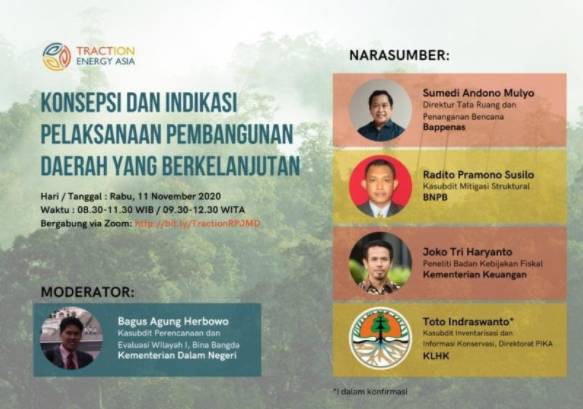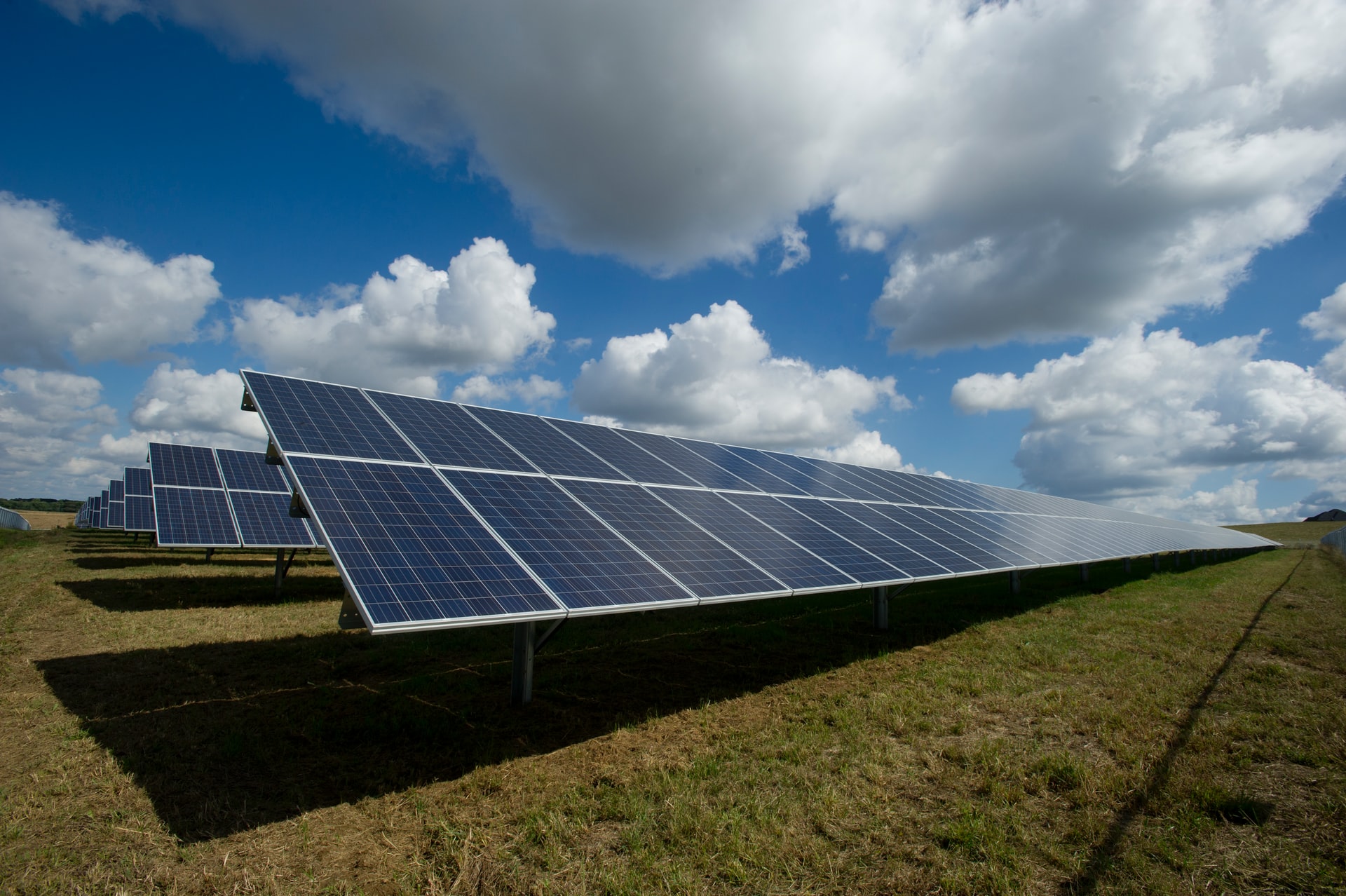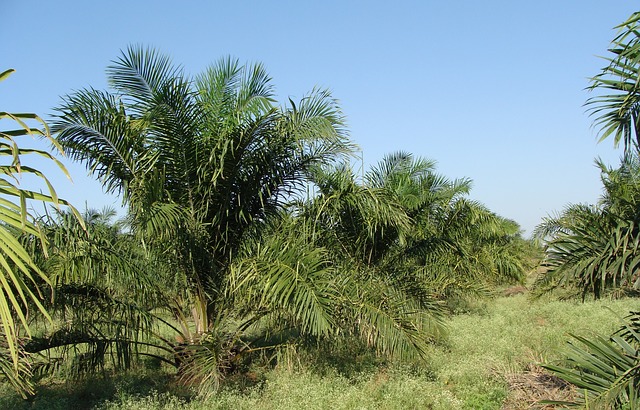By: Fariz Panghegar, Traction Energy Asia

This seminar was the first in a series of activities providing assistance for the preparation of the regional development plans (RPJMD) based on the environment and response to environmental disasters. This seminar follows-up on the FGD on “Raising the Issue of Environment and Disasters in Regional Development Activities”. The speakers in the seminar were Sumedi Andono from the Ministry of National Development Planning of the Republic of Indonesia, Radito Pramono Susilo from the Indonesian National Board for Disaster Management (BNPB), Joko Tri Haryanto, a researcher from the Fiscal Policy Agency, Ministry of Finance, and lastly Toto Indraswanto from the Ministry of Environment and Forestry of the Republic of Indonesia (KLHK). Bagus Agung Herbowo from the Directorate General of Regional Development (Bina Bangda), Ministry of Home Affairs, moderated the focus group discussion.
National Development Policy Directions in Disaster Management
In his presentation “Sustainable Development Goals Review the Medium-Term National Development Plan (RPJMN) 2019 – 2024 from the Perspective of Environmental and Disaster Issues”, Sumedi Andono Mulyo, the speaker from the Ministry of National Development Planning, explained that RPJMN identifies Indonesia as having a high risk of both natural and man-made disasters, including biological and chemical hazards. In addition, he explained that there are 3 major stages in the Disaster Management Cycle, namely the pre-disaster, emergency response, and post-disaster. The regional development planning should include disaster mitigation among these stages.
Sumedi added that there were directives from the President during the 2020 National Coordination Meeting (Rakornas) on Disaster Management, which include synergy between central and regional governments in mitigating disasters according to the characteristics of each region; preparation of contingency plans for potential disasters by heads of regional governments; a collaborative approach between the government and academics, researchers, business sector, and the communities; mass media support, improvement of human resources (HR), and institutional governance; as well as synergy between the Indonesian National Military (TNI)/Police with local governments and BNPB to support the disaster management activities.
The Disaster Management Master Plan (RIPB) policy directions in the National Medium-Term Development Plan (RPJMN) 2020–2024 are listed in the table below:
RIPB and Disaster Management Policy Directions in RPJMN 2020-2024
| NO. | RIPB POLICY DIRECTIONS | DISASTER MANAGEMENT POLICY DIRECTIONS IN RPJMN 2020–2024 |
| 1. | Strengthening disaster management legislation to be more effective and efficient | Strengthening Disaster Data, Information, and Literacy |
| 2. | Increasing synergy between institutions and stakeholders in disaster management | Strengthening Disaster System, Regulations, and Governance |
| 3. | Strengthening investment in disaster risk management in accordance with the projected increase in disaster risks, carried out with a strategy. | Improving Disaster Infrastructure and Facilities |
| 4. | Strengthening disaster management governance to be more professional, transparent, and accountable. | Integrating Cooperation between Disaster-Risk-Based Policies and Spatial Planning |
| 5. | Increasing the capacity and capability for more reliable and prompt emergency response to disasters | Strengthening Disaster Emergency Management |
| 6. | Accelerating the recovery of affected areas and communities to build a better life | Implementing Rehabilitation and Reconstruction in affected areas |
| 7. | – | Strengthening the integrated multi-threat disaster mitigation system |
Source: Presentation of the Speaker from Bappenas, 11 November 2020.
The Urgency of Regional Planning in the Mitigation of Potential Natural and Man-Made Disasters
In his presentation titled “The Formulation of the effective Regional Activity Program as an Environmental Disaster Mitigation Management”, Radito Pramono Susilo, the speaker from the Indonesian National Board for Disaster Management (BNBP), explained that there were 3,814 disasters in 2019 and 2,481 disasters from January to 31 October 2020. The types of disasters are detailed in the following table:
Comparison of Disasters Happening in Indonesia in 2019 and 2020
| NO. | TYPE OF DISASTER | TOTAL DISASTERS
IN 2019 |
TOTAL DISASTERS
IN 2020 |
| 1. | Tornado | 1,387 | 720 |
| 2. | Forest and Land Fires | 746 | 321 |
| 3. | Flood | 784 | 889 |
| 4. | Landslide | 719 | 472 |
| 5. | Drought | 123 | 29 |
| 6. | Earthquake | 30 | 15 |
| 7. | Tidal Wave/Abrasion | 18 | 29 |
| 8. | Volcanic Eruption | 7 | 5 |
| 9. | COVID-19 Epidemic | – | 1 |
| Total | 3,814 | 2,481 |
Source: Presentation of the Speaker from the Indonesian National Board for Disaster Managemen (BNPB), 11 November 2020.
According to the above table, hydrometeorological disasters, which include tornado (puting beliung), forest and land fires, flood, landslide, drought, and tidal wave or abrasion, were still dominating both in 2019 and 2020.
Citing the data from Indonesia Disaster Risk Index (IRBI) in 2013, Radito elaborated that there is no single regency/municipality that is immune from disaster threats. There are 322 regencies/municipalities with a high level of threats and 174 regencies/municipalities with a medium level of threats. To reduce the risk, Radito proposed a paradigm shift in disaster management, from responsive to preventive.
Radito explained the responsibility of the Regional Governments in disaster management based on Law Number 24 of 2007, which stipulates that preventive measures – from mitigation to preparedness and early warning – shall be implemented through development program in the pre-disaster stage to reduce disaster risks. Thus, regional governments should pay attention to the disaster risks of their regions.
The mapping of disaster-prone areas, which includes the identification of disaster-prone areas in both regencies and municipalities, can be accessed in INARISK website. The website also contains identification of objects that must be protected from disasters, such as houses, offices, schools, health centers, hospitals, markets, etc., as well as studies on the preparedness of regional governments and communities.
Strengthening the Carrying Capacity of Natural Resources in the Regional Development Planning
In his presentation titled “Formulation of Regional Programs/Activities that Strengthen the Carrying Capacity of Natural Resources”, Toto Indraswanto, the speaker from the Ministry of Environment and Forestry of The Republic of Indonesia (KLHK), presented the total forest area that should be focused on the regional development planning. The details of the forest area data can be seen in the following table:
Indonesia’s Forest Areas in 2020
| NO. | TYPE OF FOREST | AREA (Hectares) | PERCENTAGE (%) |
| 1. | Conservation Forest | 21,902,407 | 18.13% |
| 2. | Protected Forest | 29,638,486 | 24.54% |
| 3. | Limited Production Forest | 26,843,748 | 22.22% |
| 4. | Production Forest | 29,265,410 | 24.23% |
| 5. | Conservable Production Forest | 13,133,580 | 10.87% |
| Total Forest Area | 120,783,631 | 100.00% |
Source: Presentation of the Speaker from KLHK in the Seminar, 11 November 2020
In addition to forest areas, Radito also stated the importance of protecting the conservation areas to strengthen the carrying capacity of natural resources. Radito mentioned the types and total area of Indonesia conservation areas, which can be seen in the following table:
Table 10. Indonesia’s conservation areas in 2020
| NO. | TYPE OF CONSERVATION AREA | TOTAL (UNIT) | TOTAL AREA
(HECTARES) |
| 1. | Nature Reserve | 214 | 4,246,580.18 |
| 2. | Wildlife Reserve | 79 | 4,982,406.13 |
| 3. | National Park | 54 | 16,232,132.17 |
| 4. | Nature Recreation Park | 134 | 830,813.23 |
| 5. | Grand Forest Park | 34 | 371,124.39 |
| 6. | Game Hunting Park | 11 | 171,250.00 |
| 7. | Nature Reserve Area | 29 | 306,062.92 |
| Total | 554 | 27,140,369.01 |
Source: Presentation of the Speaker from KLHK in the Seminar, 11 November 2020
According to Radito, there are six aspects that should be considered by the regional government in the management of conservation areas based on past experience. The aspects include the laying out of a common cross-sector agenda, consistency and adaptive management approach, formulating the identity of conservation and ecotourism management in conservation areas, building public hope and trust, building networks and partnerships as social capital, and consistently practicing good governance―which includes principles of transparency, participation, collectivity, responsibility, and accountability―in the implementation of regional development.
Improvement of Sectoral Governance in Environment and Disaster Mitigation
Joko Tri Haryanto, a researcher from the Center for Climate Finance and Multilateral Policy in Fiscal Policy Agency, Ministry of Finance, delivered a presentation titled “Budget Tagging and Improvement of Sectoral Governance”. He emphasized Indonesia’s commitment to controlling climate change, which is manifested at the global level in its active participation in the Conference of the Parties (COP) UNFCCC (United Nation for Climate Change Conference).
The Indonesian Government is committed to controlling climate change through the ratification of various international policies and adopting them in the national laws, policies, and action plans, as set out in the National Action Plan for Reducing Greenhouse Gas Emissions (RAN-GRK) in 2011; National Action Plan for Climate Change Adaptation (RAN-API) in 2014; Indonesia Nationally Determined Contribution (NDC) in 2016; RPJMN 2020–2024 document; National Priority No. 6 Environmental Development, Disaster Resilience, and Climate Change; Priority Program: Low-Carbon Development, Disaster Resilience and Climate Change; and National Action Plan for Sustainable Development Goals in 2017 to control the climate change based on SDG No. 13.
Joko pointed out various problems in public planning and budgeting, including program planning that is disconnected to budgeting and causes suboptimal funding, differences between terminologies used in the action plan (RAN/D) and budgeting, overlapping authorities, and limited/insufficient development funding.
To solve these problems, the Government performed reformation such as: (1) improvement of budget tagging and budget scoring scheme governance, (2) changes in sectoral management mechanism, from sectoral to cross-sectoral, and (3) performance-based incentive and disincentive schemes. Challenges faced in the fiscal management are state revenues, central government expenditures, regional expenditures, and financing. In his presentation, Joko added that the Government has implemented Climate Budget Tagging to achieve SDG No. 13.
Joko explained that Climate Budget Tagging is designed to develop a system that allows for tracking, monitoring, and reporting expenditures on climate change mitigation/adaptation. Moreover, the system is also designed to mark budgets that are relevant to climate change mitigation/adaptation activities so that regional government’s expenditures allocated and realized in the implementation of mitigation/adaptation can be identified and reported. He later explained that in the Climate Budget Tagging there are climate change adaptation keywords according to both national and regional contexts to conduct tracking, identification, and calculation of government expenditures for financing programs/activities related to climate change adaptation by referring to RPJMD Document.
Joko ended his presentation by explaining the benefits of Climate Budget Tagging, which among others are to improve reporting and tracking budgets related to climate change in the State Revenue and Expenditure Budget (APBN) and strengthen the ability of policymakers to manage and allocate domestic financial resources more effectively and efficiently. Furthermore, to facilitate the decision-making process of directing and prioritizing policies in order to meet the goals of climate change mitigation and adaptation, as well as to determine the proper mechanism to allocate financial resources in order to achieve the national commitment.
Photos of “Concepts and Indicators for Sustainable Regional Development Implementation” Seminar
The speakers’ presentations were met by various responses from the regional development planner participants. The Regional Development Planning Agency (Bappeda) of Bengkalis Regency, Riau, pointed out the importance of valid data resources for several national agenda, such as Sustainable Development Goals (SDG) and its derivatives. Bappeda of Bengkalis Regency proposed the National Development Planning Agency (Bappenas), the Directorate General of Regional Development of Ministry of Home Affairs (Bina Bangda), Ministry of Home Affairs, and Ministry of Administrative and Bureaucratic Reform to co-create an application for cascading performance pattern, starting from RPJMN to Regional Apparatus Organization (OPD) Strategic Plan. Sumedi Andono Mulyo, the speaker from the Ministry of National Development Planning, responded to the Bapedda of Bengkalis with an explanation of cascading synchronization of performance indicators as part of the electronic-based government system contained in the One Data One Map Policy, including the integration of SIPD application system (Ministry of Home Affairs), Krisna (Bappenas), as well as Sakti and Omspan (Ministry of Finance).
On the other hand, Regional Disaster Management Agency (BPBD) of Siak Regency, Riau, inquired about the mitigation implementation for abrasion in coastal areas as well as for forest and peatland fire disaster. The question was answered by Toto Indraswanto from Ministry of Environment and Forestry of The Republic of Indonesia (KLHK), who explained that the coastal abrasion can be prevented by planting mangroves, blackboard trees, and other coastal plants. The prevention program can be carried out structurally and non-structurally. Regarding prevention of peatland fires, according to Toto, communities and business actors should work hand in hand with the local BPBD and Forestry OPD at the provincial level to avoid agricultural and plantation practices that cause peatland fires.





